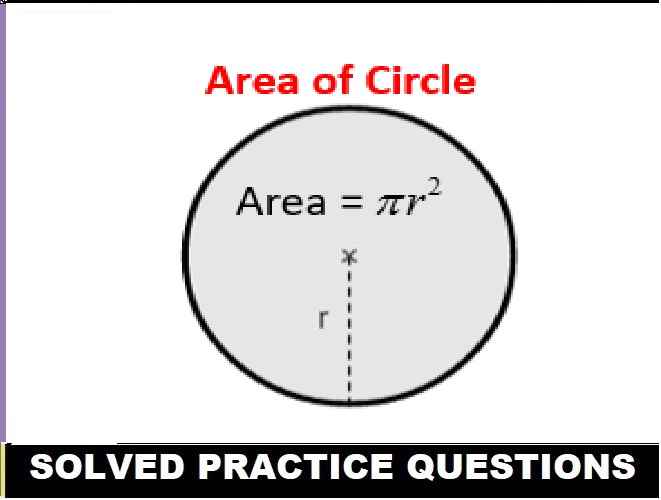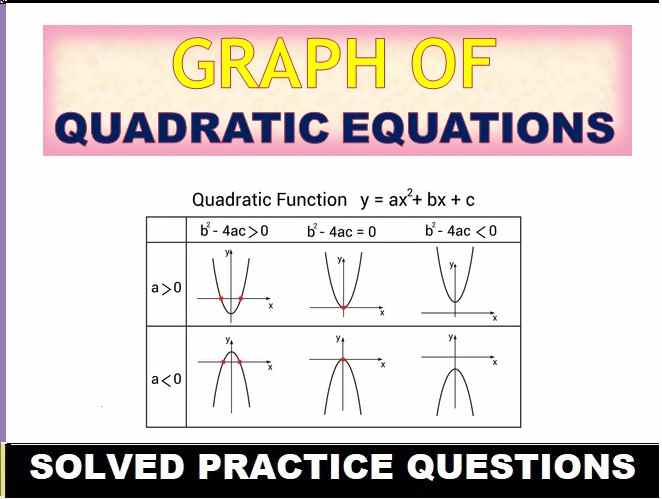Machines Pulley Class-10 Concise ICSE Selina Physics Solutions Chapter-3. We Provide Step by Step Answer of Exercise-3(A), MCQs-3(A), Numericals-3(A), Exercise-3(B), MCQ-3(B), and Numericals -3(B) Questions of Exercise-3 Machines ICSE Class-10 . Visit official Website CISCE for detail information about ICSE Board Class-10.
| Board | ICSE |
| Publications | Selina Publication |
| Subject | Physics |
| Class | 10th |
| Chapter-3 | Machines (Pulley) |
| Book Name | Concise |
| Topics | Solution of Exercise-3(A), MCQs-3(A), Numericals-3(A), , Exercise-3(B), MCQ-3(B), and Numericals -3(B) |
| Academic Session | 2021-2022 |
Machines Pulley Class-10 Concise ICSE Selina Physics Solutions Chapter-3
-: Select Exercise :-
Exercise-3(A), MCQs-3(A), Numericals-3(A),
Exercise-3(B), MCQ-3(B), and Numericals -3(B)
Important Topics of Chapter-3 Machines for ICSE Class-10
Concept of machine including load, fulcrum and effort.Today is various type machine discuss in Solution of Selina Physics but complex machines are combination of simple machine. Although there are many term in machine yet velocity ratio and efficiency are most important term among machine . There are many simple machine in Chapter -3 of Selina Physics such that liver.pulley, inclined plane but in ICSE Physics 2021 only liver and pulley is in latest syllabus.
Excercise -3 (B) “Machines” Selina Physics Solution, Chapter -3,
Machines Pulley Class-10 Concise ICSE Selina Physics Solutions
Page 66
Question 1
What is a fixed pulley? State its one use.
Answer 1
Fixed pulley: A pulley which has its axis of rotation fixed in position, is called a fixed pulley.
Single fixed pulley is used in lifting a small load like water bucket from the well.
Question 2 (Machines Pulley Class-10 Concise)
What is the ideal mechanical advantage of a single fixed pulley? Can it be used as a force multiplier?
Answer 2
The ideal mechanical advantage of a single fixed pulley is 1.
It cannot be used as force multiplier.
Question 3
Name the pulley which has no gain in mechanical advantage. Explain, why is such a pulley is then used?
Answer 3
There is no gain in mechanical advantage in the case of a single fixed pulley. A single fixed pulley is used only to change the direction of the force applied that is with its use, the effort can be applied in a more convenient direction. To raise a load directly upwards is difficult.
Question 4
What is the velocity ratio of a single fixed pulley?
Answer 4
The velocity ratio of a single fixed pulley is 1.
Question 5
In a single fixed pulley, if the effort moves by a distance x downwards, by what height is the load raised upwards?
Answer 5
The load rises upwards with the same distance x.
Question 6
What is a single movable pulley? What is its mechanical advantage in the ideal case?
Answer 6
Single movable pulley: A pulley, whose axis of rotation is not fixed in position, is called a single movable pulley.
Mechanical advantage in the ideal case is 2.
Question 7
Name the type of single pulley that has an ideal mechanical advantage equal to 2. Draw a labeled diagram of the pulley mentioned by you.
Answer 7
A single movable pulley act as a force multiplier.
Diagram:
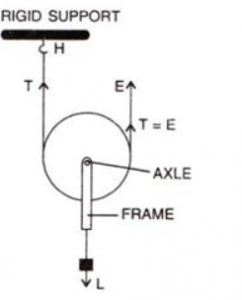
Question 8 (Machines Pulley Class-10 Concise)
Give two reasons why the efficiency of a single movable pulley system is not 100%.
Answer 8
The efficiency of a single movable pulley system is not 100% this is because
(i)The friction of the pulley bearing is not zero ,
(ii)The weight of the pulley and string is not zero.
Question 9
In which direction the force need be applied, when a single pulley is used with a mechanical advantage greater than 1? How can you change the direction of force applied without altering its mechanical advantage? Draw a labelled diagram of the system.
Answer 9
The force should be in upward direction.
The direction of force applied can be changed without altering its mechanical advantage by using a single movable pulley along with a single fixed pulley to change the direction of applied force.
Diagram:
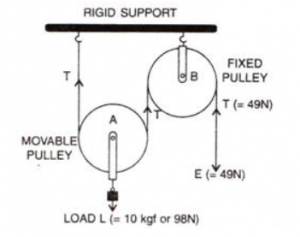
Page 67
Question 10
What is the velocity ratio of a single movable pulley? How does the friction in the pulley bearing affect it?
Answer 10
The velocity ratio of a single movable pulley is always 2.
Question 11
In a single movable pulley, if the effort moves by a distance x upwards, by what height is the load raised?
Answer 11
The load is raised to a height of x/2.
Question 12
Draw a labelled diagram of an arrangement of two pulleys, one fixed and other move able. In the diagram, mark the directions of all forces acting on it. What is the ideal mechanical advantage of the system? How can it be achieved?
Answer 12
Diagram:
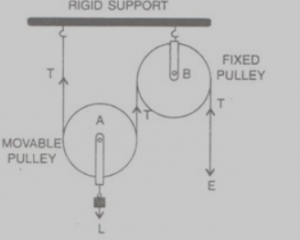
Ideal mechanical advantage of this system is 2. This can be achieved by assuming that string and the pulley are mass less and there is no friction in the pulley bearings or at the axle or between the string and surface of the rim of the pulley.
Question 13
The diagram alongside shows a pulley arrangement.
(a) Name the pulleys A and B.
(b) In the diagram, mark the direction of tension on each strand of string.
(c) What is the purpose of the pulley B?
(d) If the tension is T, deduce the relation between (i) T and E, and (ii) E and L.
(e) What is the velocity ratio of the arrangement?
(f) Assuming that the efficiency of the system is 100%, what is the mechanical advantage?
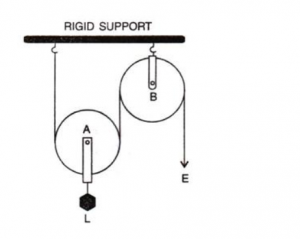
Answer 13
(a)
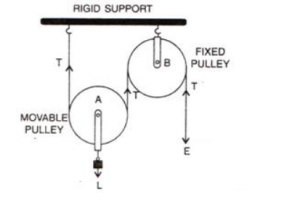
(b)The fixed pulley B is used to change the direction of effort to be applied from upward to downward.
(c)The effort E balances the tension T at the free end, so E=T
(d)The velocity ratio of this arrangement is 2.
(e)The mechanical advantage is 2 for this system (if efficiency is 100%).
Question 14
State four differences between a single fixed pulley and a single movable pulley.
Answer 14
| Single fixed pulley | Single movable pulley |
| 1.It is fixed to a rigid support. | 1.It is not fixed to a rigid support. |
| 2.Its mechanical advantage is one. | 2.Its mechanical advantage istwo. |
| 3.Its velocity ratio is one. | 3.Its velocity ratio is two. |
| 4.The weight of pulley itself does not affect its mechanical advantage. | 4. The weight of pulley itself reduces its mechanical advantage. |
| 5.It is used to change the direction of effort | 5.It is used as force multiplier. |
Question 15
The diagram alongside shows and arrangement of three pulleys A, B and C. The load is marked as L and the effort as E.
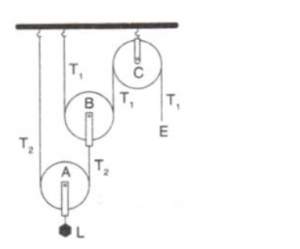
(a) Name the pulleys A, B and C.
(b) Mark in the diagram the direction of load (L), effort (E) and tension T1 and T2 in the two strings.
(c) How are the magnitudes of L and E related to the tension T1?
(d) Calculate the mechanical advantage and velocity ratio of the arrangement.
(e) What assumptions have you made in parts (c) and (d)?
Answer 15
(a) Pulleys A and B are movable pulleys. Pulley C is fixed pulley.
(b)
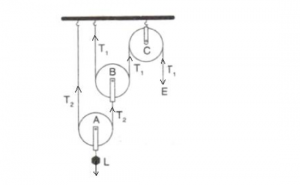
(c) The magnitude of effort E = T1
And the magnitude of L= 22 T1 = 4 T1
(d)The mechanical advantage = 22 = 4
The velocity ratio = 22 = 4
(e) Assumption: the pulleys A and B are weightless.
Question 16 (Machines Pulley Class-10 Concise)
Draw a diagram of combination of three movable pulleys and one fixed pulley to lift up a load. in the diagram, show the directions of load, effort and tension in each strand. Find: (i) the mechanical advantage, (ii) velocity ratio and (iii) the efficiency of the combination in ideal situation.
Answer 16
Diagram:
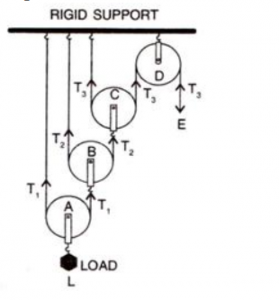
Tension T1 in the string passing over the pulley A is given as
2T1 = L or T1 = L/2
Tension T2 in the string passing over the pulley B is given as
2T2 = T1or T2 = T1/2 = L/22
Tension T3 in the string passing over the pulley C is given as
2T3 = T2orT3 = T2/2 = L/23
In equilibrium, T3 = E
E =L/23
Mechanical advantage = MA = L/E = 23
As one end of each string passing over a movable pulley is fixed, so the free end of string moves twice the distance moved by the movable pulley.If load L moves up by a distance x, dL = x, effort moves by a distance 23x, dE = 23x

Question 17
Draw a diagram of a block and tackle system of pulleys having a velocity ratio of 5. In your diagram indicate clearly the points of application and the directions of the load L and effort E. Also mark the tension T in each strand.
Answer 17
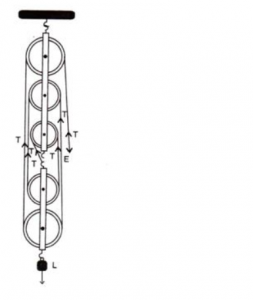
Question 18
Give reasons for the following :
(a) In a single fixed pulley, the velocity ratio is always more than the mechanical advantage.
(b) The efficiency of a movable pulley is always less than 100%.
(c) In case of block and tackle system, the mechanical advantage increases with the increase in the number of pulleys.
(d) The lower block of a block and tackle pulley system must be of negligible weight.
Answer 18
(a) In a single fixed pulley, some effort is wasted in overcoming friction between the strings and the grooves of the pulley; so the effort needed is greater than the load and hence the mechanical advantage is less than the velocity ratio.
(b) This is because of some effort is wasted in overcoming the friction between the strings and the grooves of the pulley.
(c) This is because mechanical advantage is equal to the total number of pulleys in both the blocks.
(d) The efficiency depends upon the mass of lower block; therefore efficiency is reduced due to the weight of the lower block of pulleys.
Question 19
Name a machine which is used to:
(a)Multiply force
(b)Multiplied speed, and
(c)Change the direction of force applied.
Answer 19
(a)Multiply force: a movable pulley.
(b)Multiply speed: gear system or class III lever.
(c)Change the direction of force applied: single fixed pulley.
Question 20
State whether the following statements are true or false.
(a) The velocity ratio of a single fixed pulley is always more than 1.
(b) The velocity ratio of a single movable pulley is always 2.
(c) The velocity ratio of a combination of n movable pulleys with a fixed pulley is always 2n.
(d) The velocity ratio of a block and tackle system is always equal to the number of strands of the tackle supporting the load.
Answer 20
(a) The velocity ratio of a single fixed pulley is always more than 1.(false)
(b) The velocity ratio of a single movable pulley is always 2.(true)
(c) The velocity ratio of a combination of n movable pulleys with a fixed pulley is always 2n.(true)
(d) The velocity ratio of a block and tackle system is always equal to the number of strands of the tackle supporting the load. (true)
MCQ – 3 ( B ) Selina Concise ICSE Physics Solutions, Chapter -3, “Machines”
Machines Pulley Class-10 Concise ICSE Selina Physics Solutions
Page 68
Question 1
A single fixed pulley is used because it:
(a) Has a mechanical advantage greater than 1
(b) Has a velocity ratio less than 1
(c) Gives 100% efficiency
(d) Helps to apply the effort in a convenient direction.
Answer 1
It helps in applying effort in a convenient direction.
Question 2
The mechanical advantage of an ideal single movable pulley is:
(a) 1
(b) 2
(c) less than 2
(d) less than 1.
Answer 2
The mechanical advantage of an ideal single movable pulley is 2.
Question 3
A movable pulley is used as :
(a) a force multiplier
(b) a speed multiplier
(c) a device to change the direction of effort
(d) an energy multiplier
Answer 3
Force multiplier
NUMERICALS:- 3 (B) Concise Selina ICSE Physics Chapter-3 Machines
Machines Pulley Class-10 Concise ICSE Selina Physics Solutions
Page 68
Question 1
A woman draws water from a well using a fixed pulley. The mass of bucket and water together is 6 kg. The force applied by the women is 70 N. calculate the mechanical advantage. (Take g = 10 m s-2).
Answer 1
The force applied by the women is= 70 N
The mass of bucket and water together is = 6 kg
Total load = 6 x 10 = 60 N

Question 2
A fixed pulley is driven by a 100 kg mass falling at a rate of 8.0 m in 4.0 s. It lifts a load of 75.0 kgf. Calculate:
(a) The power input to the pulley taking the force of gravity on 1 kg as 10 N.
(b) the efficiency of the pulley, and
(c) the height to which the load is raised in 4.0 s.
Answer 2
(a) Effort driving the pulley is,
E = mg
= 100 × 10
= 1000 N
Input power is,
Pin = 2000 W
(b) Load pulley by the pulley is,
L = 75 × 10
= 750 N
Hence, M.A is,
M.A = L / E
= 750 / 1000
= 0.75
When the effort moves by a distance d downwards,
the load moves by the same distance upwards. Thus,
V.R = 1
Therefore efficiency is,
η = M.A. / V.R.
= 0.75 / 1
= 0.75
= 75%
(c) The load moves by the same distance upwards when the effort moves by a distance d downwards. So, height to which the load moves is 8 m
Question 3
A single fixed pulley and a movable pulley both are separately used to lift a load of 50 kgf to the same height. Compare the efforts applied.
Answer 3
In case of a single fixed pulley, the effort i.e Ef needed to lift a load is equal to the load itself.
Hence, Ef = L
Ef = L
The effort needed to lift a load is equal to half the load
Em = 50 kgf / 2
= 25 kgf
Hence, the ratio of efforts applied by the respective pulley is
Ef / Em = 2 / 1
Therefore Ef : Em = 2: 1
Question 4 (Machines Pulley Class-10 Concise)
In a block and tackle system consisting of 3 pulleys, a load of 75 kgf is raised with an effort of 25 kgf. Find: (i) the mechanical advantage, (ii) the velocity ratio, and (iii) the efficiency.
Answer 4
Load = 75 kgf
Effort= 25 kgf
n = 3
MA = Load/Effort = 75/25 = 3
or MA = n = 3
velocity ratio VR = n = 3

Question 5
A block and tackle system has 5 pulleys. If an effort of 1000 N is needed in the downward direction to raise a load of 4500 N, calculate:
(a)The mechanical advantage,
(b)The velocity ratio and,
(c)The efficiency of the system.
Answer 5
A block and tackle system has 5 pulleys. (n = 5)
Effort=1000 N
Load=4500 N

Question 6
In figure 3.32 draw a tackle to lift the load by applying the force in the download direction.
(a) Mark in the diagram the direction of load L and effort E.
(b) If the load is raised by 1 m, through what distance will the effort move?
(c) State how many strands of tackle are supporting the load.
(d) What is the mechanical advantage of the system?
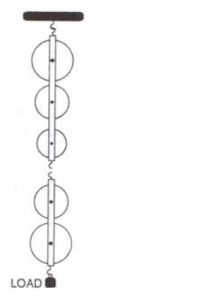
Answer 6
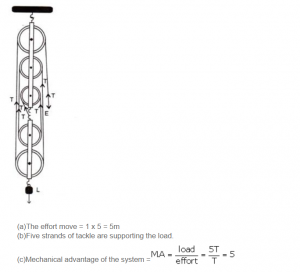
Question 7
A pulley system has a velocity ratio 3. Draw a diagram showing the point of application and direction of load (L), effort (E) and tension (T). If lifts a load of 150 N by an effort of 60 N. Calculate its mechanical advantage. Is the pulley system ideal? Give reason.
Answer 7
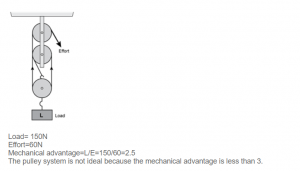
Question 8 (Machines Pulley Class-10 Concise)
Figure 3.33 shows a system of four pulleys. The upper two pulleys are fixed and the lower two are movable.
(a) Draw a string around the pulleys. Also show the point of application and direction in which the effort E is applied.
(b) What is the velocity ratio of the system?
(c) How are load and effort of the pulley system related?
(d) What assumption do you make in arriving at your answer in part (c)?
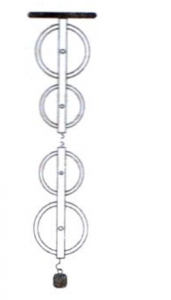
Answer 8 (a)

(b) Velocity ratio of the system = n = 4
(c) The relation between load and effort
M.A. = load / effort = n = 4
Load = 4 × effort
(d)
(i) There is no friction in the pulley bearings
(ii) Weight of lower pulleys is negligible and
(iii) The effort is applied downwards.
Question 9
Figure 3.34 shows a block and tackle system of pulleys used to lift a load.
(a) How many strands of tackle are supporting the load?
(b) Draw arrows to represent tension T in each strand.
(c) What is the mechanical advantage of the system?
(d) When load is pulled up by a distance 1 m, how far does the effort end move?
(e) How much effort is needed to lift a load of 100 N?
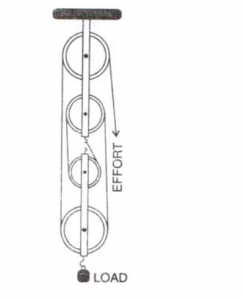
Answer 9
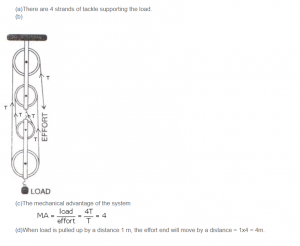
(c) The mechanical advantage of the system
M.A. = Load / Effort
= 4T / T
= 4
(d) When load is pulled up by a distance 1 m, the effort end will move by a distance
= 1 × 4 = 4m
(e) M.A = Load / Effort
4 = 100 / effort
Effort = 100 / 4
= 25 N
Page 69
Question 10
A block and tackle system has the velocity ratio 3. Draw a labelled diagram of the system indicating the points of application and the directions of load L and effort E. A man can exert a pull of 200 kgf. (a) What is the maximum load he can raise with this pulley system if its efficiency is 60%? (b) If the effort end moves a distance 60 cm, what distance does the load move?
Answer 10
For block and tackle system, V.R. = n (number of pulleys)
Hence, n = 3
The diagram is as shown below

Question 11
You are given four pulleys and three strings. Draw a neat and labelled diagram to use them so as to obtain a maximum mechanical advantage equal to 8. In your diagram mark the directions of load L, effort E and tension in each strand.
What assumptions have you made to obtain the required mechanical advantage?
[Hint: Three movable pulleys with one fixed pulley]
Answer 11
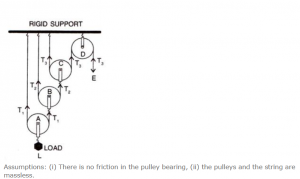
Return to Concise Selina ICSE Physics Class-10
Thanks
